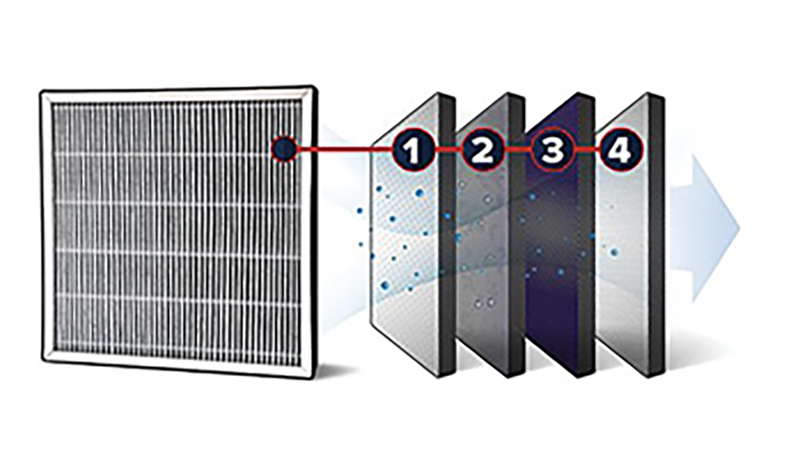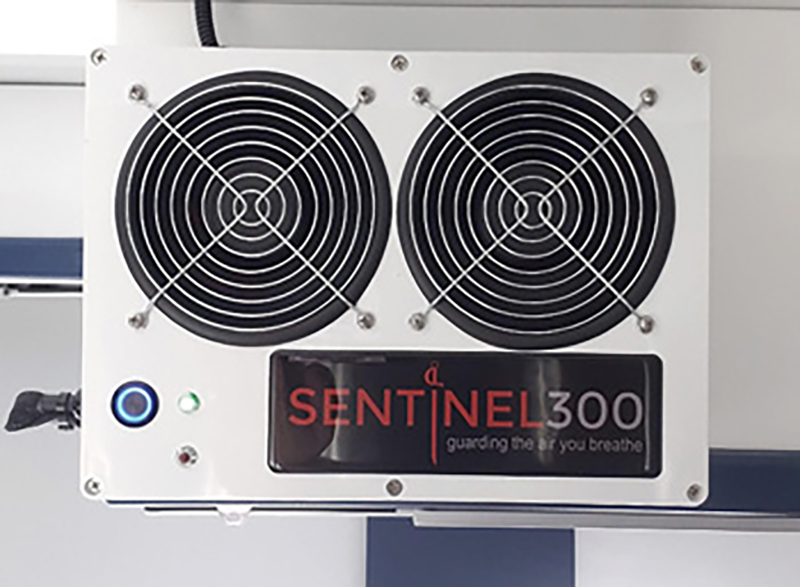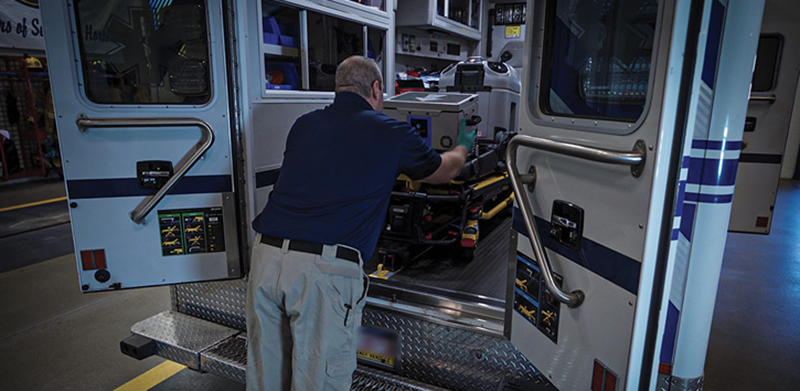Decontaminating the inside of ambulances can be performed during routine maintenance, at the end of a shift, or after particular patient procedures such as when Aerosol Generating Procedures (AGPs) have been performed in the rig.
Emergency medical services (EMS) providers are using an array of decon equipment solutions to be sure their rigs are free of all types of contamination.
Jeff Hicks, OEM channel manager for Task Force Tips (TFT), says his company’s CrewProtect™ 100 apparatus decon System cleans the air in full size fire rigs and ambulances, removing cancer-causing particulates; volatile organic compounds (VOCs); and aerosols carrying viruses like CoV-2, bacteria, and mold. Hicks points out the system can be installed horizontally or vertically in any interior location using provided mounting brackets.
“CrewProtect uses a cartridge that will last six months,” Hicks says. “At five months, an indicator light comes on showing the amount of life left. The cartridges capture, encapsulate, and neutralize the airborne particles and turn them into harmless items. That means used cartridges are safe to be discarded as normal trash.”
Hicks notes that TFT also makes the CrewProtect 20 apparatus decon system, which he says is ideal for chiefs’ vehicles, wildland trucks, and tiller cabs. “CrewProtect cleans contaminants in the air and neutralizes odors but does not clean surfaces,” he says. “However, it cleans the air before contaminants can lodge on surfaces, because its chief aim is to get the contaminants out of the air before they can be inhaled. The system operates as long as the vehicle is running.”
Scott Hacker, vice president of sales and marketing for Toxic Suppression, says his company makes the Sentinel Purifier, an air and hard surface sanitizer that’s designed to operate while the vehicle is occupied. “The Sentinel Purifier uses needlepoint bipolar ionization (NPBI) from GPS air that neutralizes VOCs and pathogens, including four different efficacy tests vs. SARS-CoV-2,” Hacker says.

1 Task Force Tips makes the CrewProtect™ 100 apparatus decon system that is often fitted in ambulance patient modules. (Photos 1-2 courtesy of Task Force Tips.)

2 TFT’s CrewProtect uses a multi-stage cartridge system that has four filters: a preliminary filter, a molecular filter, an antimicrobial filter, and a HEPA filter.

3 Toxic Suppression has this Sentinel Purifier installed in an ambulance built by Frazer Ltd. (Photos 3-4 courtesy of Toxic Suppression.)

4 The Sentinel 300 Purifier produces no ozone and requires no filters, bulbs, or consumable components.
He notes, “The Sentinel is Underwriters Laboratories (UL) certified for no ozone production and requires no filters, bulbs, or any consumable component. This is an active technology that in testing has shown that in the first five minutes it neutralizes 80% of contaminants and takes only 30 minutes to neutralize 99.89% of contaminants in the air and on surfaces.” Hacker says Toxic Suppression also makes the Sentinel IQ Vehicle Air Quality Monitoring and Alerting System and that his company also is launching a neutral pH disinfectant with a 15-second dwell time that can neutralize SARS-CoV-2 and fentanyl exposure.
Trent Starnes, EMS corporate account manager for Ecolab’s Bioquell, says Bioquell BQ-EMS is a mobile decontamination system that uses hydrogen peroxide vapor to kill pathogens in EMS vehicles. “The Bioquell BQ-EMS uses a 35% hydrogen peroxide solution to deliver a 99.9% sporicidal reduction, which is known as a 6-log kill, the same standard of decontamination that high containment labs apply for areas hosting research on hazardous organisms,” Starnes points out.
Starnes says it takes between 45 and 60 minutes for the decon process to be completed, depending on the size of the vehicle.

5 Ecolab makes the Bioquell BQ-EMS, a mobile decontamination system that uses hydrogen peroxide vapor to kill pathogens in EMS vehicles. (Photos 5-6 courtesy of Ecolab Bioquell.)

6 An EMS worker loads a BQ-EMS unit in the back of an ambulance, preparatory to deconning the interior.

7 AeroClave makes the RDS 3110 portable decontamination system that can be used for hands-free decon or in a hand-applied mode. (Photo 7 courtesy of AeroClave.)
“All cycle times are subject to configuration, loading, and environmental conditions,” he says. “The system is simple to set up and takes only a few minutes. Simply load and place the equipment, power it up, and each component will automatically connect wirelessly.” Starnes adds that because the system vaporizes the hydrogen peroxide, it is a dry vapor technology and not wet or a fog. “The department can leave sensitive electronics in the patient module,” he says, “and devices with internal fans should be run during the decon process.”
Mike Quinoy, senior vice president of commercial sales for AeroClave, says AeroClave makes the RDS 3110 and RDS 6110 systems “that are in service with many of the largest fire and EMS organizations in the country as well as with many of the smallest. The RDS 3110 is a rugged, lightweight, and person-portable decontamination system that can be used to effectively treat spaces up to 5,000 cubic feet.”
Quinoy notes that the unit weighs 48 pounds and can be operated in either an aerosolized application mode for hands-free area decontamination or in a hand-applied mode using an optional AeroClave Portable Applicator (APA). “The system’s environmentally friendly disinfectant solution produces no harmful byproducts for the environment,” he adds, “contains no VOCs, and is 100% biodegradable. In addition, it is ready to use, so no mixing is required.”
Another decon method that some vendors produce for EMS rigs is an air cleaner that uses bipolar ionization, which helps catch contaminants in media filters and assists in inactivating viruses, germs, and odors. The bipolar ionization system is inserted into the ambulance’s heating, ventilation, and air-conditioning ductwork and creates molecules with both positive and negative ions that move through the air stream attaching to particles, gas molecules, and pathogens and are then extracted from the air with a media filter.
ALAN M. PETRILLO is a Tucson, Arizona-based journalist, the author of three novels and five nonfiction books, and a member of the Fire Apparatus & Emergency Equipment Editorial Advisory Board. He served 22 years with the Verdoy (NY) Fire Department, including in the position of chief.

